Shipwreck Regia dragamina R.D.7
-
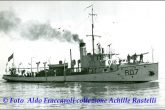
The Italian minesweeper R.D.7 during an operation at North Adriatic Sea in October 1940 (© Foto Aldo Fraccaroli collezione Achille Rastelli) -
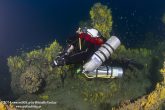
Near the davit of the mine-sweeping system (© 2014 www.wetklik.gr by Milonakis Kostas and www.grafasdiving.gr) -
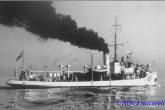
R.D 7 at North Adriatic Sea in October 5th 1940 (© Aldo Fraccaroli) -
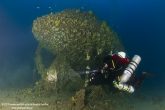
The rudder and the propeller of the ship are still discreet until today (© 2014 www.wetklik.gr by Milonakis Kostas and www.grafasdiving.gr) -
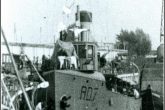
R.D 7 at Lido, Venice in October 1940 (© Foto Aldo Fraccaroli collezione Achille Rastelli) -

The smoker and the framework of the ship as they are today (© 2014 www.wetklik.gr by Milonakis Kostas and www.grafasdiving.gr) -
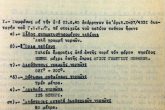
Entry of the creation of the minefield of Monis-Methana in the War Diary of the Greek Royal Navy (War Diary, volume A, Navy History Service) -

The commander of the 21st Minesweeper Fleet of the Italian Royal Navy. Antonio Uccini in the cabin of R.D 7 in October 1940 (© Aldo Fraccaroli) -
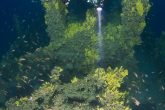
The davit and the 2 stern wind-receivers of R.D 7 (© 2014 www.wetklik.gr by Milonakis Kostas and www.grafasdiving.gr) -
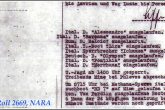
The entry concerning the sinking of R.D 7 in the War Diary of the German commander of the Sea Defense of Attika (T1022, Roll 2669, NARA) -

The indicative location of the wreck at the south part of Aigina -
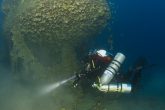
The ruins around the wreck are not discreet as they are intensely covered by benthos (© 2014 www.wetklik.gr by Milonakis Kostas and www.grafasdiving.gr) -
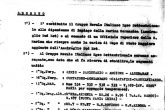
The units of Marisudest in Greece in May 1941. Between the ships of the 2nd Minesweeper Division we can see the R.D 7 (PG-46157, T1022, Roll 2550, NARA) -
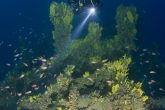
At the middle part of the ship, looking towards the stern (© 2014 www.wetklik.gr by Milonakis Kostas and www.grafasdiving.gr) -
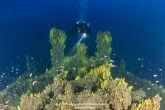
The two characteristic wind-receivers of R.D7 and the davit (© 2014 www.wetklik.gr by Milonakis Kostas and www.grafasdiving.gr) -
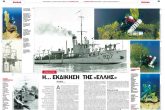
Published in the journal Free Press. -

Video from the shipwreck R.D.7(Regia dragamina R.D.7).
The War Diary of the commander of the Sea Defense of Attika (Kommandant der Seeverteidigung Attika) that was found in the German historic records of World War II includes, among the other fact reports of June 15th 1942, a short input that mentions the below:
“At 07.15am, at the minefield of Methana, the Italian minesweeper RD7 sank after crashing into a mine. Ships that left from Perdika (Aigina), managed to save 6 persons from the total of 24 crew members.”
This is a fact that would be unknown to the world if there were not this diary input, the old fishermen of Perdika and an extremely detailed article of the Italian researcher and ship photographer Aldo Fraccaroli under the title of “Il Dragamine R.D 7”. Today only few would know about this fact as well as about the existence and the end of the Italian Ship R.D 7 that was the first Italian royal minesweeper that came to Greece, included in the second division of minesweepers (2a Squadriglia Dragamine) of the Italian Royal Navy, immediately after the occupation of the Greek lands by the Axis forces, in spring 1941.
The identification of this wreck as being the R.D 7 in August 2010 and its special historic meaning, led 4 years later, in February 2014, to organize and realize a diving in this wreck. The first people that dived and saw it, 73 years after its sinking were the members of Antonis Grafas diving group.
The diving realized after a detailed and systematic preparation had as main goal the photoshooting and filming of the wreck that is in a depth of 100m at the area were the Greek minefield of Agios Georgios, Methana was located during the World War II. The field research and the visual material that they took showed from the very beginning that the wreck was of the Italian Royal minesweeper RD 7 that sank with at least 18 losses in June 1942.
Construction and technical characteristics of R.D 7
Since the end of 19th century, the Italian Royal Navy, Regia Marina Italiana, by including the torpedo-cruisers Tripoli & Goito, announced its decision to include ships of a displacement of 900 until 1000 tones in its fleet. After including the minesweepers Partenope & Minerva new bases were set in order to create a very modern fleet that increased significantly until the beginning of the World War I, in 1914.
In opposition to the other well organized sea units, the Italian Royal Navy did not have enough minesweepers, except for the 47 ships of open sea bought by Japan which had been transformed into minesweepers having the distinctive marks G1 until G47. This lack led Regia Marina in the middle of the big war in 1916, trying to enhance and modernize its fleet, to sign national contracts with Italian shipyards in order to construct 69 minesweepers of 200 tones each. From these minesweepers which had the distinctive marks R.D (i.e Regia Dragamine meaning Royal Minesweeper), 26 ships started operating even before the end of the World War I. From 1918 and immediately after the end of the war until 1926, another 28 minesweepers from the ordered ones were given to the Italian Royal Navy.
Despite some significant construction differences that these ships had between them [1], the general shipbuilding form, according to the plans, was similar. The shipbuilding line of the ship was similar to a tugboat having on its bow a navy gun of 76/40mm [2] on a tower in order to be used to sink the cut mines and to protect the ship during a naval combat. In order to be protected by air attack, the ships had 2 water-cooled Colt machine guns of 6,5mm.
One of these minesweepers with the serial construction number 7 was R.D 7 which, as already mentioned, sank in June 15th, 1942 after crashing into a mine. As a result, it is located until today in a depth of 100m at the south part of Moni Aigina island.
R.D 7 was ordered at the shipyard of Cantieri navali Tosi at Tarant, Italy. Its construction started in May 15th 1916 and it launched in September 28th of the same year delivered to Regia Marina in March 2nd 1917.
The general technical characteristics and specialties of this ship were:
Name: Regia Dragamine No 7
Distinctive mark: R.D. 7
Nationality: Italian
Gun: Regia Marina Italiana
Type: Minesweeper
Constructor: Cantieri navali Tosi di Taranto
Serial Number: 7
Displacement: 215,67 tones
Total length: 35,25m
Width: 5,88m
Draught: 2,11m
Engine: Vertical reciprocating engine of triple expansion
Power: 950hps
Indicative speed: Firstly 14,4 knots, later 9 knots
Operational Range: 750 nautical miles with a speed of 14 knots
Main weaponry: 1 nautical anti-air gun of 76/40mm
Auxiliary weaponry: 2 water-cooled Colt machine guns of 6,5mm
Indicative crew: 22 persons
The operational action and the sinking of R.D. 7
During the period of Middle War and until the spring of 1941, R.D 7 belonged to the 21st Fleet of Minesweepers of the Italian Royal Navy (XXI Flottiglia Dragamine), operating in North Adriatic having its base at Lido, Venice [3]. During this period and due to its age and massive use, its speed decreased from 14 knots to 9 knots.
In March 26th 1941, the ship, with captain Mr. Salvatore Galatolo, was sent to the sea area of the Greek-Albanian frontiers where it stayed until April 1941 when the convention between the Greek Army and the Axis Forces was singed by the General Mr. Georgios Tsolakoglou. Then, in May of the same year, R.D 7 went to Piraeus via Patra where it was included in the newly founded 2nd Division of the 39th Fleet of Minesweepers of the Italian Royal Navy, operating basically at the area of Saronikos under the administration of Marisudest (Comando Gruppo Navale dell’ Egeo Settentrionale).
At night of June 14th 1942, R.D 7 left from Piraeus, with captain the officer [4] Vito Guglielmi, considered to be the supervisor ship of a mission south of the island of Aigina. That was the last mission of the ship as in the morning of the next day, June 15th 1942, and while it was sailing at the sea area between Methana peninsula and the island of Moni Aigina, R.D 7 crashed into a mine of the old Greek minefield of Agios Georgios Methana and as a result it sank.
This minefield was created at night of October 29th until 30th 1940 by the ships of the Greek Royal Navy called Strimon and Aliakmon, assisted by the torpedo destroyer Vassilissa Olga. The minefield had 115 mines of Vickers type, located in a straight line with a distance of 50m between each other that were supposed to be in a depth of 3m under the surface. The minefield was from the lighthouse of the island Moni, south of Aigina, until the edge of Agios Georgios, Methana [5] in a total distance of 5700m. The minefield’s plan was realized and announced in August 23rd 1940 by the Hellenic Navy General Staff (Confidential Order Κ/27/4332), immediately after the sinking of cruiser Elli by the Italian submarine Delfino at Tinos, in August 15th of the same year.
After the occupation of Greece by the Axis forces and the delivery of the Greek minefield’s plans to the German Navy authorities, the minefields of Agios Georgios, Methana-Moni Aigina and Fleva – Tourlou Aigina were included by the German army in the defense net of the Coastal Protection of Attiki and they were the only active minefields of Saronikos Bay until December 1942, when the mine putting of the north Aegean Sea started by the Italian Barletta.
The History Directory of the Italian Navy (Ufficio Storico della Marina Militare) probably until today does not know the exact reason of R.D 7 sinking as the official opinion of U.S.M.M, according to the Navi Militari Perdute [6], mentions that:
“It was not possible to clarify if the sinking was provoked due to a cut mine or due to a torpedo explosion that was shot by an enemy submarine”. [7]
According to the German diary inputs, the R.D 7 sinking must had been very abrupt because, due to the explosion and the sinking, 18 out of a total of 24 crew members got lost, including the captain Vito Guglielmi. As mentioned by the German records, the fishermen with their boats from Perdika, a village south of Aigina, helped immediately the castaways and saved 6 out of 24 crew members of R.D 7. The Italian sources mention that there were more than 20 losses and only 5 survivors. [8]
The Wreck
The wreck of R.D 7 is sat on the keel in a sandy and muddy sea bottom in a maximum depth of 100m having the axis bow-stern at a direction of almost 275 degrees. The bow and the machine gun of 76/40mm are missing. The bow is totally cut in front of the cockpit and the officer’s accommodation areas. From the three of the five in total ventilators, only some remaining are left and their holders are totally discreet and located at the correct places. The ship’s smoker is destroyed however its hole, which is covered with some metal remaining, is still discreet. Exactly in front of the smoker, there is still a part of the broken net of the ship and in front of that there are parts of the superstructure and the cockpit covered by benthos.
In the middle of the ship there are the main characteristics of the ship that obviously show the identity of the ship. There are two davits of the middle ship that at R.D 7 there were located only at the right side of the ship where the lifeboats were located. At the same area there are also four characteristics of R.D 7; two parallel ventilators at the end of the engine room, from which the top parts are missing, and the remaining of both supporters of the radiotelegraphy antennas.
The part of the middle ship until the stern is in a quite good condition. The shipbuilding line of the ship, which is similar to a tugboat’s, is very discreet and obvious. Except for the remaining of the two already mentioned ventilators of the engine room, the seine davit of the mine fishing system is also discreet, as well as the skylight and the engine room’s roof. Outside the wreck we can also see the rudder and the propeller of the ship. Around the wreck there are many breakages which are not very discreet as they are covered by benthos.
Conclusion
The wreck of R.D 7, that is not just a monument of the World War II but also a sea tomb of Italian sailors that got lost in it, is added to the long list of the Italian war and commercial ships that sank at the wide area of Saronikos Bay during the period when Regia Marina was operating in Greece, from May 1941 until September 1943. Even if it was a small ship, its operational role as a minesweeper of the Italian Royal Navy enables it to be an important “witness” of the facts that have to do with the Italian and Greek history, as it sank by a mine of the Greek minefield of Methana-Moni, located by Greek minesweepers one day before the beginning of the Greek-Italian War. The loss of R.D 7 is the only loss of this minefield that continued to exist until the end of the World War II.
If someone visits today the south part of the desolated island of Moni will meet in a depth of almost 12m, at the area called “Fokospilia”, the remaining of a Vickers mine that probably was from the already mentioned minefield and which stayed there until today to remind us the sufferings of the war and the wreck of the Italian minesweeper R.D 7 located close by.
To sum up, I would like first of all to underline that this article is dedicated to the memory of the Italian photographer and researcher Aldo Fraccaroli and I would also like to express a special thank to my friend and real knowledgeable, researcher and secretary of the Associazione Nazionale Marinai d’Italia, Maurizio Brescia for his unquestioning help to the research of R.D 7 and to the assistance offered to understand the structure of Regia Marina Italiana and the way it operates.
DG
Referrals, Complementary, Clarifications
[1] The minesweepers that had significant differences with the other ships, were constructed at the shipyard of Cantieri navali di Voltri at Genova. They are three ships that were wooden and had 2 smokers (see Bagnasco, p.23)
[2] The R.D 7 firegun had the same displacement but it was longer as it was coming from the series of fireguns that was ordered for the war ships of Cavour and Doria type (see Bagnasco, p.23)
[3] The only photos from R.D 7 are from that period. They are photos of Aldo Fraccaroli when he visited the 21st Minesweeper Fleet of the Italian Royal Navy at Lido, Venice in October 5th 1940.
[4] Sottotenente CREM (Corpo Reale Equipaggi Marittimi)
[5] See War Diary of the Royal Navy, volume A, p. 186, Navy History Service, Votanikos, Athens
[6] Edizione III, Compil. Ammiraglio Tognelli, USMM, 1965, p. 87
[7] Το γεγονός ότι η γερμανική ημερολογιακή καταχώρηση αναφέρει σαφώς την πρόσκρουση του πλοίου σε νάρκη, δημιουργεί απορίες για την μη παροχή της συγκεκριμένης πληροφορίας στο Marisudest και την Supermarina. The fact that the German diary input clearly mentions the crash of the ship into a mine, brings doubts as to why this information is not mentioned in Marisudest and Supermarina.
[8] See Fraccaroli, p. 110 and Bagnasco, p. 16
Sources
Bagnasco, Erminio: Aldo Fraccaroli: Fotografo Navale 1933-1993 sessant´anni di storia della Marina italiana attraverso le immagini, Ed. Albertelli, 1996
Fraccaroli, Aldo: Il Dragamine “R.D.7”, Storia Illustrata, N. 301, A. Mondadori Editore, Dicembre 1982
War Diary of the Royal Navy, volume A, October-November 1940, Navy History Service, Votanikos, Athens
Kavadias, Epaminondas: The Navy War of 1940 as I lived it, Athens, 1950
Kriegstagebuch Kommandant der Seeverteidigung Attika, T1022/Roll 2669, NARA
Lupinacci, Pier Filippo (Compilatore), Tognelli, Vittorio E. (Revisore): La difesa del traffico l´Albania, la Grecia e l´Egeo, La Marina italiana nella seconde Guerra mondiale, Ufficio Storico della Marina Militare, Vol. IX, Roma, 1965
Navi Militari Perdute, Ufficio Storico della Marina Militare, La Marina italiana nella seconde guerra mondiale, Vol. II, 3 Ed., Roma, 1965
Report for the actions of the Royal Navy during the war of 1940-1944, Volume A: From the prewar period until the occupation of Greece (27 April 1941), Editions of Historic Service of the Royal Navy 1953

